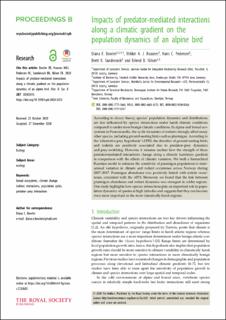Impacts of predator-mediated interactions along a climatic gradient on the population dynamics of an alpine bird
Bowler, Diana Elizabeth; Kvasnes, Mikkel Andreas Jørnsøn; Pedersen, Hans Christian; Sandercock, Brett; Nilsen, Erlend Birkeland
Peer reviewed, Journal article
Published version

Åpne
Permanent lenke
https://hdl.handle.net/11250/2731882Utgivelsesdato
2020Metadata
Vis full innførselSamlinger
Originalversjon
Bowler, D. E., Kvasnes, M. A. J., Pedersen, H. C., Sandercock, B. K. & Nilsen, E. B. (2020). Impacts of predator-mediated interactions along a climatic gradient on the population dynamics of an alpine bird. Proceedings of the Royal Society of London. Biological Sciences, 287(1941): 20202653. doi: 10.1098/rspb.2020.2653Sammendrag
According to classic theory, species’ population dynamics and distributions are less influenced by species interactions under harsh climatic conditions compared to under more benign climatic conditions. In alpine and boreal ecosystems in Fennoscandia, the cyclic dynamics of rodents strongly affect many other species, including ground-nesting birds such as ptarmigan. According to the ‘alternative prey hypothesis’ (APH), the densities of ground-nesting birds and rodents are positively associated due to predator–prey dynamics and prey-switching. However, it remains unclear how the strength of these predator-mediated interactions change along a climatic harshness gradient in comparison with the effects of climatic variation. We built a hierarchical Bayesian model to estimate the sensitivity of ptarmigan populations to interannual variation in climate and rodent occurrence across Norway during 2007–2017. Ptarmigan abundance was positively linked with rodent occurrence, consistent with the APH. Moreover, we found that the link between ptarmigan abundance and rodent dynamics was strongest in colder regions. Our study highlights how species interactions play an important role in population dynamics of species at high latitudes and suggests that they can become even more important in the most climatically harsh regions. boreal ecosystems, climate change, indirect interactions, population cycles, predator–prey interactions
